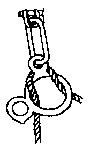Overview
[ Top
| Version B
| Version C
| Return to Plate Descenders
]
Version A
(#979)
Technical Details
I built this device in 2005.
I milled my Hopf device from 1/2" (12.7 mm.) 6061-T6
aluminum plate. The central hole and outer holes have 65 and 46 mm.
internal diameters respectively, and the ring thickness is 11.2 mm.
between rings and 12.3 mm. on the periphery. My Hopf weight
197 g.
 The Hopf
is used like a figure eight descender,
but it has a third ring that provides some additional flexibility.
The third ring’s main function is to provide a convenient tie-off
point for stopping on rappel or for supporting a climber after
belaying a fall. Personally, I think that the various side-horn
type eights (e.g., various Russian
eights, S.B.C.I. Sidewinder)
provide more convenient tie-offs, and I dislike belaying with
a figure eight because I like to
have more friction in my belay device.
The Hopf
is used like a figure eight descender,
but it has a third ring that provides some additional flexibility.
The third ring’s main function is to provide a convenient tie-off
point for stopping on rappel or for supporting a climber after
belaying a fall. Personally, I think that the various side-horn
type eights (e.g., various Russian
eights, S.B.C.I. Sidewinder)
provide more convenient tie-offs, and I dislike belaying with
a figure eight because I like to
have more friction in my belay device.
The extra ring can also perform the same functions that ears
do on a a figure eight with ears;
i.e., greatly increasing the size of the device in return for
reducing the chance of a girth hitch forming on rappel.
I first learned of the Hopf from Norman Kingsley’s 1975 book
Icecraft. He credits the design to Dr. Hopf of Bern,
Switzerland. Dr. Hopf applied for a patent in 1968 and received Swiss Patent #494,041 for the descender. When I visited Walter Marti (the original Jumar
manufacturer) in 1982, he showed me a Hopf, but I was unable to
find one in any of the Bernese (or any other Swiss) climbing shops,
nor was I able to find one during my visit to Switzerland for
the 1997 International Congress of Speleology. I finally settled
for making my own. The dimensions I chose are reasonable but somewhat
arbitrary; like the figure eight,
one can make useful Hopfs with a wide variety of ring sizes. The reason that I separated the two eyes by 135° instead of 90° simply because that is what I remembered, incorrectly. For machining simplicity, I omitted the small nubbin on the tie-off eye.
[ Top
| Version A
| Version C
| Return to Plate Descenders
]
Version B
(#1136)
Technical Details
In early 2007, John Sharples arranged a trade with the Newcastle
Ramblers Bushwalking Club (Australia) for this Hopf device.
The Hopf, Version B is made from aluminum. It is 171 mm. tall,
180 mm. wide, and 12 mm. thick. The rope hole is 96 mm. in
diameter, the eye 32.7 mm., and the auxiliary hole 41.7 mm.
This Hopf weighs 231 g.
There are no markings on this Hopf device.
John tried to find out where this Hopf came from, but no one
knew for sure. The best he could find was, "there is a suspicion
that it was made by a local caving club." Although it looks
like it was milled from aluminum plate, some of the marks on the
inside of the three holes look like it was forged. This Hopf has
a small nubbin on the side hole like the one shown in Kingsley’s
book. This helps hold the rope in place if one chooses to drape
it over the side ring (e.g., to provide additional friction on
rappel).
[ Top
| Version A
| Version B
| Return to Plate Descenders
]
Version C
(#1243, 1462)
Technical Details
I acquired one Hopf, Version C from Kathleen Merritt in 2010, a second from David G Keenan II in 2015, and a third from Wild Gear Deals in 2022.
Version C is 161 mm. tall, 127 mm. wide, 12 mm. thick, and weighs 183 g.
There are no markings on this device
These Hopf Enten are significantly smaller than Version B.
Kathleen Merritt’s eBay listing described this as follows:
European rappelling and belaying device in the shape of a duck called the Ente (German for duck) purchased in 1974 from a Swiss mountain
guide and has never been used. Brand is unknown.
Based on this description, I think Version C is an "authentic" Hopf.
Dr. Hopf of Bern,
Switzerland applied for a patent in 1968 and received Swiss Patent #494,041 for the descender.
[ Top
| Version A
| Version B
| Version C
| Return to Plate Descenders
]



 The Hopf
is used like a
The Hopf
is used like a